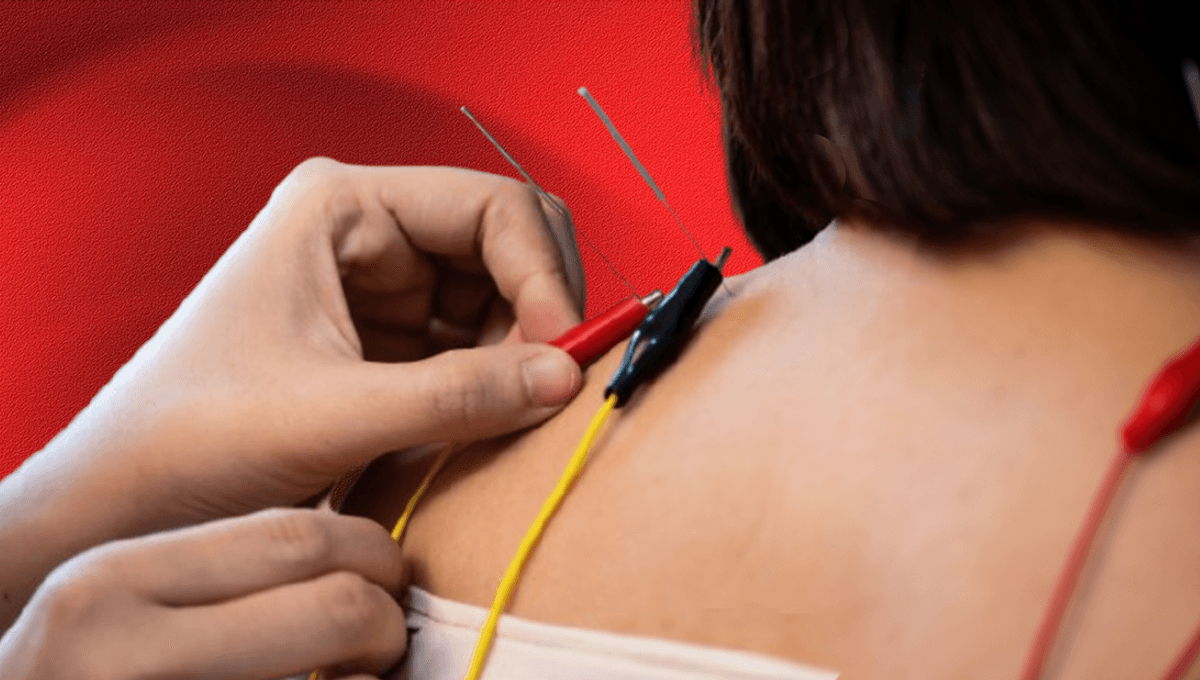
Is it possible to pop a few fine needles into your skin, hook them up to a little bit of electricity, and cure all manner of ills? That’s what some people believe electroacupuncture, the zappier version of standard acupuncture, can do – but is there any truth in it?
What is electroacupuncture?
Electroacupuncture is a spin on the traditional Chinese medicine practice of acupuncture. This practice revolves around the concept of qi (pronounced “chee”), a “life force” that flows through the body in channels called meridians.
It’s believed that illness can be caused when the flow of qi is blocked. Placing super-thin needles at various places around the body known as acupuncture points and then manipulating them with the hands, causing them to vibrate, is thought to restore the flow of qi and bring back balance and health.
The Western take on this practice, which is generally thought of as alternative or complementary medicine, involves placing needles based on anatomy to stimulate sensory nerves. It’s not clear exactly how this works to alleviate health issues.
Electroacupuncture is based on the same principles, but instead of the acupuncture needles being manipulated by hand, they are instead “activated” by applying a weak electrical current to them. It’s claimed that this can help with a range of issues, from pain to musculoskeletal disorders.
Does electroacupuncture work?
Let’s cut to the chase – the scientific evidence to suggest that electroacupuncture actually does what some might claim it to do is currently limited. That’s not to say that researchers haven’t been looking into it; in fact, if you search “electroacupuncture” on Google Scholar or PubMed, you’ll find plenty of studies, some going back decades – but that body of research has not yet been sufficient to see the practice make its way into routine clinical practice.
Still, that doesn’t mean we should ignore all that work – so does any of it at least look promising at the moment? Let’s take a look at pain management, one of the major areas that electroacupuncture research focuses on.
Studies have investigated everything from problems like neck and back pain through to headaches and migraine, but one 2021 randomized clinical trial looked specifically at whether electroacupuncture could help to reduce chronic musculoskeletal pain in cancer survivors.
The trial involved 360 participants, all of whom were cancer survivors, and split them into three groups: 145 received electroacupuncture in 10 sessions over the course of 12 weeks, 143 received auricular acupuncture (where needles are inserted into specific points in the ear) for the same amount of time, and the remaining 72 received their usual care.
Participants were asked to rate the severity of their pain on a scale, zero being no pain and 10 being the worst pain imaginable. By the end of the 12 weeks, compared to those who received their usual care, participants who received electroacupuncture reported a reduction in the severity of their pain by 1.9 points.
While the results look promising, they’re still limited; for one, the authors rightly point out that the relative reduction in pain seen is small enough that it may not be considered clinically relevant. The study size itself is small too, which makes it more difficult to generalize the findings.
It also lacked something called a sham control, where everything about the electroacupuncture procedure is mimicked, except needles aren’t actually inserted into the skin. Sham controls help researchers to determine what could be a true effect of a treatment versus a placebo effect, so without one, it’s hard to know if even the small effect seen was actually down to the electroacupuncture.
These are the kinds of limitations that appear to be reflective of electroacupuncture research more widely, with other reviews pointing out low study quality, differences in how the treatment is applied, and a lack of rigorous study design in general.
Is electroacupuncture safe?
As with regular acupuncture, electroacupuncture should be safe as long as it is carried out correctly. This means, for example, using single-use sterile needles designed to be used for acupuncture – these are regulated by the Food and Drug Administration.
If electroacupuncture isn’t properly delivered, there can be a risk of damage to organs or the central nervous system, and though reports haven’t been widely identified, there’s still a possibility of electric shocks or burns if someone doesn’t know what they’re doing with electrical currents.
One way to make it more likely that appropriate safety measures are in place is to go to someone with a license to practice acupuncture and electroacupuncture. A state license is a requirement in some places in the US – but not all.
Some people do experience mild side effects, too. These might include feeling faint, dizzy, or nauseated, as well as bruising or bleeding at the points where the needles were inserted, a tingling sensation, or other general discomfort. Electroacupuncture may also not be safe for people with pacemakers, those with conditions such as epilepsy or bleeding disorders, or people with a history of seizures.
The bottom line? The jury is still out on the efficacy of electroacupuncture. If someone is deciding whether or not to try it, it’s best they speak to their healthcare provider first to determine if it’s the best course of action.
All “explainer” articles are confirmed by fact checkers to be correct at time of publishing. Text, images, and links may be edited, removed, or added to at a later date to keep information current.
The content of this article is not intended to be a substitute for professional medical advice, diagnosis, or treatment. Always seek the advice of qualified health providers with questions you may have regarding medical conditions.
Source Link: Electroacupuncture Is Acupuncture's Livelier Cousin – But Does It Work?